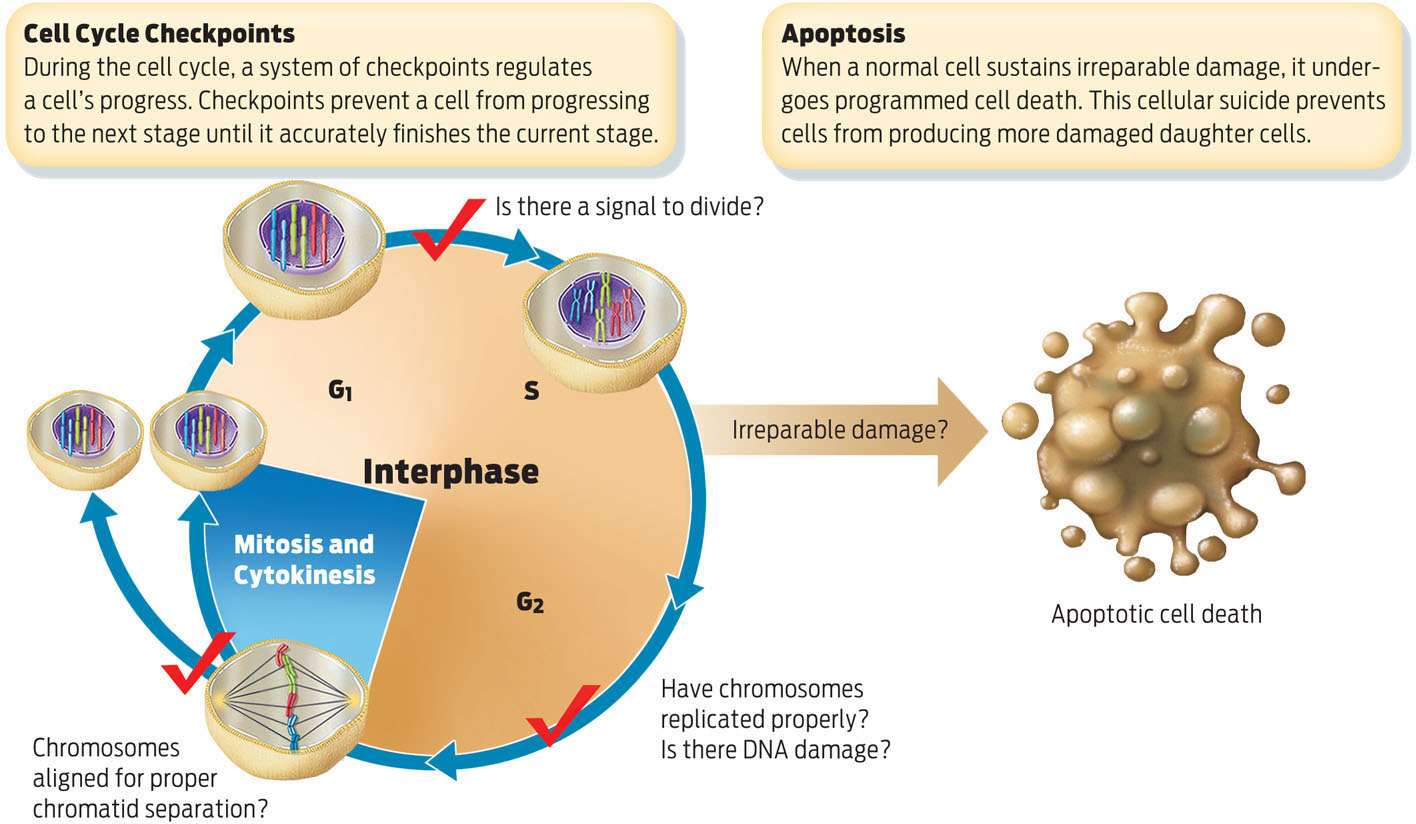WHEN DIVISION RUNS AMOK: CANCER
MUTATION A change in the nucleotide sequence of DNA.
Normally, cells divide only on demand, in response to growth signals. When cells no longer need to divide—for example, when a wound has healed or worn-out tissues have been replaced—these growth signals are turned off and cells take a break. The cells pause in their life cycle and stop dividing (although they still carry out other normal cellular functions). By contrast, cancer cells divide haphazardly. Cancer is cell division run amok.
CELL CYCLE CHECKPOINT A cellular mechanism that ensures that each stage of the cell cycle is completed accurately.
What causes certain cells to “go rogue”? Cancer results when cells accumulate DNA sequence changes. Every time a cell replicates its DNA, for example, there is a small chance that it will make a mistake—insert the wrong nucleotide, for instance. Normally, such mutations (see Chapter 10) are caught by the cell and fixed at what’s known as a cell cycle checkpoint. Cells have a series of such checkpoints, which monitor each stage of the cell cycle and check for mistakes. Checkpoints also prevent progression of the cell cycle until previous stages have been successfully completed. At one checkpoint, for example, proteins scan DNA for damage or incorrect base pairing. If problems are detected, one of two things happens: either the cell ramps up DNA repair mechanisms, giving itself time to fix DNA mistakes, or, in cases of severe and irreparable damage, the checkpoints direct a cell to commit suicide, a process called apoptosis. Checkpoint mechanisms like these ensure that cells divide accurately and only when necessary (INFOGRAPHIC 9.4).
APOPTOSIS Programmed cell death; often referred to as cellular suicide.
Normal cells have mechanisms to ensure that cell division is carried out precisely and only when necessary. Regulated cell division ensures that adequate cell number and healthy tissue structure are maintained in the body.

TUMOR A mass of cells resulting from uncontrolled cell division.
Even with these repair mechanisms, however, cells with mutations do occasionally manage to complete the cell cycle and divide. This is especially likely if the mutations affect the genes that code for those proteins that function as checkpoints. Defective checkpoint proteins don’t do their jobs, so additional mistakes continue to accumulate in these cells. When cells accumulate enough DNA damage to interfere with multiple checkpoints, the result is cancer. Cancer cells plow through the cell cycle uninhibited, divide uncontrollably, and in many cases eventually form a mass of cells called a tumor (INFOGRAPHIC 9.5).
Cancer cells have damaged checkpoint mechanisms, which enable them to divide when they should not. This means that DNA damage or errors in chromosome separation are passed on to daughter cells. These cells can bypass apoptosis. With each cell division, the damage is perpetuated and additional errors in DNA accumulate.

Cancer kills by crowding out normal cells and invading other organs, causing them to fail. Cancer cells also secrete a variety of chemicals that wreak havoc on the body’s biochemistry, with potentially fatal complications.
Ovarian cancer, which affects more than 20,000 women a year in the United States, is especially insidious. There are no clear symptoms and no effective screening tests. When the condition is eventually discovered, often the cancer has already spread, and the prognosis is poor. Although many patients respond well initially to treatment, the cancer usually recurs. Cure is rare. This is why taxol made such a name for itself in early clinical trials with ovarian cancer—it was effective when everything else had failed.